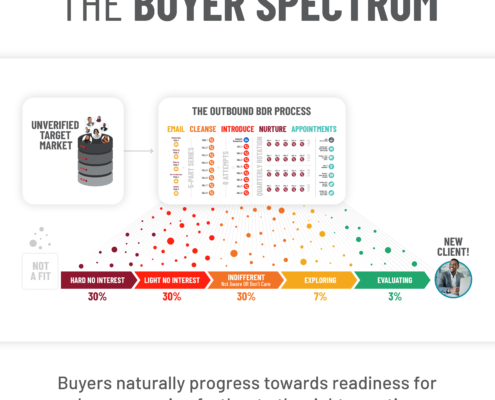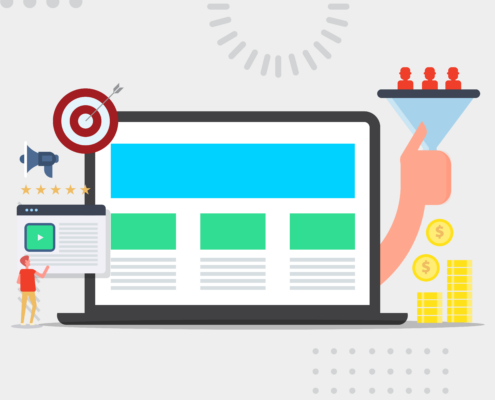

One of the biggest mistakes that businesses make is aiming to target their sales and marketing efforts to “anyone who wants to buy.” In a perfect world, EVERYONE would invest in your products or services so you have an endless stream of revenue pulling in.
However, we don’t live in a perfect world, and targeting “anyone who wants to buy” isn’t enough to yield a sustainable and predictable sales pipeline. Therefore, you must define your target audience and direct your sales, marketing, and lead generation efforts toward that market.
In this blog, we’ll cover all you need to know about identifying your target market, including the following:
B2B Target Audience Explained (And Why It’s Important to Understand)
A B2B (business-to-business) target audience refers to the specific group of businesses or organizations that a company aims to reach, engage, and ultimately convert into customers or clients for its products or services. This audience represents the key stakeholders, decision-makers, and influencers within other businesses or organizations.
Understanding your B2B target audience is important for business growth for several reasons, including:
- More precision in lead generation and marketing
- Appropriate resource allocation
- Better product development based on the needs of decision-makers
- Longer-term customer relationship building
Steps to Help Your B2B Company Properly Identify Your Target Audience
If you’re not sure where to start with your target market identification process, here are some crucial steps to get you started.
Step 1. Conduct Industry Market Research
Conducting industry market research empowers B2B companies to pinpoint their target market effectively. It provides critical insights into market dynamics, trends, and competitive landscapes. By understanding the industry’s size, growth potential, and evolving needs, businesses can identify the most lucrative segments.
In-depth research also reveals customer behaviors, preferences, and pain points. With this data, B2B companies can create ideal customer profiles and buyer personas, ensuring tailored marketing strategies that resonate with their target audience.
Ultimately, industry market research serves as a foundational step, enabling businesses to make informed decisions and focus resources where they will have the greatest impact in reaching and engaging their preferred customers.
Step 2. Segment Current Customers Based on Similar Criteria
Segmenting current customers based on similar criteria helps B2B companies identify their target market by revealing common characteristics and preferences among their most successful clients.
By grouping customers with similar industry types, company sizes, geographic locations, or needs, businesses can discern patterns and trends within their customer base. This segmentation clarifies which segments are the most profitable and satisfied, serving as a valuable blueprint for identifying new prospects who closely align with these characteristics.
Customer segmentation enables B2B companies to tailor their marketing and sales efforts to effectively reach and engage potential customers who are more likely to convert, leading to improved targeting and business growth.
Step 3. Create Detailed Customer Profiles and Buyer Personas
Creating detailed customer profiles and buyer personas aids B2B companies in effectively identifying their target market by providing a deep understanding of their ideal customers. These profiles encapsulate demographics, firmographics, psychographics, and buying behavior. They serve as clear representations of the characteristics and needs of potential clients.
By leveraging these profiles, businesses can align their products, services, and marketing strategies with the specific preferences and pain points of their target audience. This precision enhances the efficiency of marketing efforts, ensuring that resources are directed toward attracting and engaging the right customers.
For more insight into how you can create detailed buyer personas for your target market, read our blog here.
Step 4. Determine What Your Ideal Client Looks Like
Determining ideal customer profiles (ICPs) helps B2B companies precisely identify their target market by creating a strategic blueprint. ICPs define the key characteristics of the perfect customer for a business, including industry, company size, pain points, and buying behavior.
By focusing on these specific attributes, companies can streamline their marketing and sales efforts, ensuring they resonate with the most promising prospects. This approach minimizes wasted resources and maximizes ROI, as it directs attention towards the segments most likely to convert and generate revenue.
Step 5. Identify Common Pain Points and How Your Company Can Resolve
Identifying common pain points is a powerful tactic for B2B companies to pinpoint their target market. By understanding the specific challenges and problems shared by potential customers, businesses can tailor their products or services to address these pain points. This approach not only demonstrates a deep understanding of the audience’s needs but also positions the company as a valuable solution provider.
For example, let’s say that you’re a commercial cleaning company and many businesses in your area are encountering a wave of sickness with their employees. Since this is a pain point between all these businesses, your cleaning company can use this common problem as a way to promote your cleaning services, ensuring employees stay healthy so they can focus on their everyday responsibilities.
Step 6. Develop Value Propositions Tailored to Each Customer Segment
Developing value propositions tailored to each customer segment is instrumental in B2B companies’ ability to identify their target market effectively. These tailored propositions articulate how a product or service addresses the specific needs, pain points, and goals of each segment.
By aligning value propositions with the unique challenges faced by distinct customer groups, businesses can resonate more strongly with their ideal audience. This approach enhances the likelihood of capturing the attention and interest of potential customers, ensuring that resources are directed toward engaging those most likely to convert and become loyal clients.
Step 7. Perform Competitor Analysis
Performing a competitor analysis is crucial for B2B companies to effectively identify their target market. By studying competitors’ strategies and customer segments, businesses gain insights into which market niches are being served and where gaps exist.
Analyzing competitors’ strengths, weaknesses, and market positioning allows companies to differentiate themselves and tailor their offerings to capture market share within specific segments. This strategic intelligence helps in selecting the most viable and profitable target audience, enabling businesses to compete effectively and position themselves as industry leaders.
Step 8. Distribute Customer Surveys and Hold Client Interviews
Distributing customer surveys and conducting client interviews are invaluable tools for B2B companies to identify their target market. These methods directly engage existing customers to gather insights into their needs, preferences, and pain points. By collecting first-hand data, businesses can create detailed customer profiles and buyer personas, providing a clear picture of their ideal audience.
The feedback obtained through surveys and interviews helps in refining product offerings, messaging, and targeting strategies. This customer-centric approach ensures that resources are directed toward attracting and engaging prospects who closely match the characteristics and preferences of satisfied clients, leading to more precise targeting.
Step 9. Ensure Sales and Marketing Department Market Definitions Are Aligned
Ensuring alignment between sales and marketing departments on market definitions is vital for a successful target market approach because it fosters a cohesive and consistent customer-facing strategy.
When both teams share a clear understanding of the target market, it minimizes confusion and improves the quality of leads generated and the messaging delivered. This synergy enhances the customer experience and streamlines the sales process, ultimately driving higher conversion rates and revenue.
Additionally, alignment facilitates regular feedback and insights sharing, enabling agile adjustments to the target market strategy as market conditions evolve.
Step 10. Consistently Network With Other Similar Companies
Consistently networking with similar companies in the B2B space is beneficial because it opens up opportunities for knowledge sharing and market insights.
By engaging with industry peers, businesses can gain a deeper understanding of market dynamics, emerging trends, and customer needs. These interactions often lead to valuable partnerships, referrals, and collaborations, expanding the network’s reach and access to potential customers.
At Abstrakt, we collaborate with businesses to help them identify (and re-evaluate) their target market. We use these findings to define what B2B lead gen strategy works best for their audience. Contact a sales rep today to learn how we can be your ultimate partner in business growth.
Top Signs It’s Time to Rethink Your B2B Target Market
Rethinking your B2B target market is a strategic decision that can have a significant impact on your business’s growth and success. Here are the top signs that it might be time to reconsider your B2B target market:
- Stagnant growth: If your business has experienced stagnant or slow growth despite consistent efforts, it could indicate that your current target market is too saturated or not providing sufficient opportunities for expansion.
- Declining customer satisfaction: A decrease in customer satisfaction, increased complaints, or a rise in customer churn may suggest that your current target market isn’t the right fit for your products or services.
- Market shifts: Changes in the industry landscape, such as emerging trends, new technologies, or shifts in customer preferences, can impact the relevance of your current target market. If your market is evolving, your target market strategy may need to evolve with it.
- Increasing industry competition: A surge in competition targeting the same market segments can make it harder to differentiate your business and capture market share. It might be time to explore underserved or less competitive segments.
- Inconsistent sales conversion: If your sales team is struggling to convert leads or close deals consistently, it could be a sign that your offerings aren’t resonating with your current target market.
- Changing business goals: As your business evolves, your goals may change. If you’re shifting your focus, expanding your product line, or entering new markets, your target market may need to change to align with your updated objectives.
- Poor feedback and data analysis: Analyzing customer feedback, market research, and sales data can provide insights into whether your current target market is still a viable fit for your business.
- Lack of profitability: If you find that your current target market isn’t generating the expected revenue and profitability, it’s essential to reevaluate your strategy.
- Difficulty in meeting customer needs: If your business struggles to meet the specific needs or demands of your target market, it may be a sign that you are not aligned with the right customer segments.
- External economic factors: Changes in the broader economic environment, such as recessions or global events, can impact the purchasing behaviors and priorities of your target market.
When you observe these signs, it’s crucial to revisit your target market strategy, conduct thorough market research, and consider whether adjustments are necessary to better align your business with the most promising market segments for sustainable growth.
How Lead Gen Outsourcing Can Help You Identify (And Reach) the Best Audience
Lead generation outsourcing can benefit growing B2B companies by leveraging specialized expertise to identify and reach their ideal audience effectively.
Outsourced teams are skilled in data analysis, prospecting, and segmentation, ensuring accurate targeting. They employ various B2B lead generation strategies, from content marketing to cold calling, to engage potential customers. This approach saves time and resources, allowing in-house teams to focus on core activities.
Moreover, outsourcing can access extensive databases and tools, enhancing the accuracy of lead identification. By collaborating with experts in lead generation, growing B2B companies can efficiently identify and reach the most promising prospects, fostering business growth.
Key Takeaways
Every business should have a B2B target audience they want to focus all their sales, marketing, and lead generation attention to. Without properly identifying your target market, you risk putting hard work, time, and resources into a business growth strategy that negatively impacts your bottom line. And we all know that’s the last thing you want.
Luckily, there are outsourced B2B lead generation teams out there that help growing businesses effectively pinpoint their target market and identify the best approach to getting their attention to pitch your company’s product and service offerings. Abstrakt is a leading outsourced sales and marketing company that empowers small to medium-sized businesses to fill their sales pipelines with prospects and qualified leads, resulting in high-converting sales meetings.
Contact one of our sales reps today to learn how we can be your leading partner in business growth!




